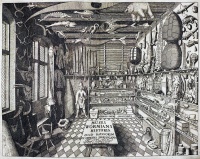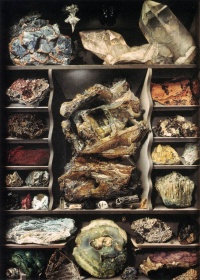Natural history illustrations
From The Art and Popular Culture Encyclopedia
(Difference between revisions)
| Revision as of 14:57, 21 January 2014 Jahsonic (Talk | contribs) ← Previous diff |
Current revision Jahsonic (Talk | contribs) |
||
| Line 1: | Line 1: | ||
| [[Image:Ernst Haeckel's Artforms of Nature of 1904.jpg|thumb|left|200px|''[[Artforms of Nature]]'' ([[1904]]) by [[Ernst Haeckel]]<br> | [[Image:Ernst Haeckel's Artforms of Nature of 1904.jpg|thumb|left|200px|''[[Artforms of Nature]]'' ([[1904]]) by [[Ernst Haeckel]]<br> | ||
| The 49th plate from Ernst Haeckel's ''Kunstformen der Natur'' of 1904, showing various [[sea anemone]]s classified as Actiniae.]] | The 49th plate from Ernst Haeckel's ''Kunstformen der Natur'' of 1904, showing various [[sea anemone]]s classified as Actiniae.]] | ||
| - | [[Image:Musei Wormiani Historia.jpg|thumb|right|200px|"[[Musei Wormiani Historia]]", the [[book frontispiece|frontispiece]] from the ''Museum Wormianum'' depicting [[Ole Worm]]'s [[cabinet of curiosities]]]] | + | [[Image:Musei Wormiani Historia.jpg|thumb|right|200px|The ''Museum Wormianum'' (1654), the [[cabinet of curiosities]] by [[Ole Worm]]]][[Image:Crystallised Minerals by Alexandre Isidore Leroy de Barde.jpg|thumb|right|200px|''[[Crystallised Minerals]]'' (first half of 19th century) by [[Alexandre Isidore Leroy de Barde]]]] |
| - | [[Image:Crystallised Minerals by Alexandre Isidore Leroy de Barde.jpg|thumb|right|200px|''[[Crystallised Minerals]]'' (first half of 19th century) by [[Alexandre Isidore Leroy de Barde]]]] | + | |
| [[Image:Audubon.jpg|thumb|right|200px|''[[The Birds of America]]'' (Color lithographic plate 321) ([[1836]]) - [[John James Audubon]]]] | [[Image:Audubon.jpg|thumb|right|200px|''[[The Birds of America]]'' (Color lithographic plate 321) ([[1836]]) - [[John James Audubon]]]] | ||
| {{Template}} | {{Template}} | ||
| - | The use of [[illustration]]s was frequently seen in works of [[natural history]]. | + | Since the Renaissance, the use of [[illustration]]s was frequently seen in works of [[natural history]]. |
| - | {{Template}} | + | [[Conrad Gessner]]'s ''[[Historiae animalium (Gesner)|Historiae animalium]]'' and [[Ulisse Aldrovandi]]'s ''[[Storia Naturale]]'' were the two earliest examples of illustrated natural history books. As Arianne Faber Kolb notes in ''[[Jan Brueghel the Elder: The Entry of the Animals Into Noah's Ark]]'': |
| - | ''[[Jan Brueghel the Elder: The Entry of the Animals Into Noah's Ark]]'' is a book by [[Arianne Faber Kolb]] on ''[[The Entry of the Animals Into Noah's Ark]]''[http://en.wikipedia.org/wiki/File:Janbrueghelark.jpg] | + | |
| - | + | ||
| - | [[Conrad Gessner]]'s and [[Ulisse Aldrovandi]]'s ''[[Storia Naturale]]'' were the two earliest examples of illustrated natural history books. | + | |
| - | + | ||
| - | "[[Conrad Gessner |Gesner]] employed the artists [[Hans Asper]], [[Jean Thomas]], and [[Lucas Schan]], and [[Aldrovandi]] worked together with [[Cristoforo Coriolano]], who made prints after drawings by [[Lorenzo Bernini]], [[Cornelius Swint]], and [[Jacopo Ligozzi]]. Gesner and Aldrovandi did not always rely on the information presented by the ancients, but tested it when possible by performing their own examinations of ... they sometimes borrowed fish and bird illustrations from [[Guillaume Rondelet]] and [[Pierre Belon]], the respective experts ..."[http://books.google.be/books?id=qFBVXPsxTxAC&pg=PA29&lpg=PA29&dq=%22Cristoforo+Coriolano,+who+made+prints+after%22&source=bl&ots=KGovXAv-Ax&sig=aw6V00Iy8zhPJcAdVqxhhLoJ1jY&hl=en&sa=X&ei=lYbeUquQHuHSywOTlIHoBA&redir_esc=y#v=onepage&q=%22Cristoforo%20Coriolano%2C%20who%20made%20prints%20after%22&f=false] | + | |
| - | The illustrations produced during the eighteenth and nineteenth century are regarded as both appealing and scientifically valid. The finer detail of the printing processes, greatly improving at this time, allowed artists to depict the minute aspects of the subject. | + | :"Gesner employed the artists [[Hans Asper]], [[Jean Thomas]], and [[Lucas Schan]], and Aldrovandi worked together with [[Cristoforo Coriolano]], who made prints after drawings by [[Lorenzo Bernini]], [[Cornelius Swint]], and [[Jacopo Ligozzi]]. Gesner and Aldrovandi did not always rely on the information presented by the ancients, but tested it when possible by performing their own examinations of ... they sometimes borrowed fish and bird illustrations from [[Guillaume Rondelet]] and [[Pierre Belon]]." |
| - | Many books and publications continued to use illustrator even after printed matter began to incorporate photography. It would be many years before [[colour printing]] would equal the illustrators' plates. | + | Perhaps the most famous historical natural history illustration, [[Dürer's Rhinoceros]] (1515), was featured in several natural history books, most famously in Gesner's ''Historiae animalium''. |
| ==Examples== | ==Examples== | ||
| ===16th century=== | ===16th century=== | ||
| *[[Historiae animalium (Gesner)]] (1551-58) | *[[Historiae animalium (Gesner)]] (1551-58) | ||
| - | *[[Dürer's Rhinoceros]] (1515) | + | *[[Dürer's Rhinoceros]] (1515) was featured in several natural history books, most famously in Gesner's [[Historiae animalium (Gesner)|''Historiae animalium'']]. |
| ===18th century=== | ===18th century=== | ||
| *[[August Johann Rösel von Rosenhof]] [http://commons.wikimedia.org/wiki/File:Roesel_von_Rosenhof_Frogs_1758.png] (1705-59) | *[[August Johann Rösel von Rosenhof]] [http://commons.wikimedia.org/wiki/File:Roesel_von_Rosenhof_Frogs_1758.png] (1705-59) | ||
Current revision

Artforms of Nature (1904) by Ernst Haeckel
The 49th plate from Ernst Haeckel's Kunstformen der Natur of 1904, showing various sea anemones classified as Actiniae.
The 49th plate from Ernst Haeckel's Kunstformen der Natur of 1904, showing various sea anemones classified as Actiniae.
|
Related e |
|
Featured: |
Since the Renaissance, the use of illustrations was frequently seen in works of natural history.
Conrad Gessner's Historiae animalium and Ulisse Aldrovandi's Storia Naturale were the two earliest examples of illustrated natural history books. As Arianne Faber Kolb notes in Jan Brueghel the Elder: The Entry of the Animals Into Noah's Ark:
- "Gesner employed the artists Hans Asper, Jean Thomas, and Lucas Schan, and Aldrovandi worked together with Cristoforo Coriolano, who made prints after drawings by Lorenzo Bernini, Cornelius Swint, and Jacopo Ligozzi. Gesner and Aldrovandi did not always rely on the information presented by the ancients, but tested it when possible by performing their own examinations of ... they sometimes borrowed fish and bird illustrations from Guillaume Rondelet and Pierre Belon."
Perhaps the most famous historical natural history illustration, Dürer's Rhinoceros (1515), was featured in several natural history books, most famously in Gesner's Historiae animalium.
Contents |
[edit]
Examples
[edit]
16th century
- Historiae animalium (Gesner) (1551-58)
- Dürer's Rhinoceros (1515) was featured in several natural history books, most famously in Gesner's Historiae animalium.
[edit]
18th century
- August Johann Rösel von Rosenhof [1] (1705-59)
- Jacob Theodor Klein , Summa dubiorum , 1743.[2]
[edit]
19th century
[edit]
See also
- Animal painting
- Botanical illustration
- Scientific illustration
- Natural history
- Zoology
- Zoological illustrations[3]
- Wildlife art
Unless indicated otherwise, the text in this article is either based on Wikipedia article "Natural history illustrations" or another language Wikipedia page thereof used under the terms of the GNU Free Documentation License; or on research by Jahsonic and friends. See Art and Popular Culture's copyright notice.




